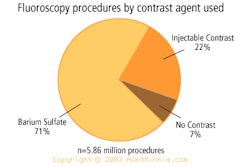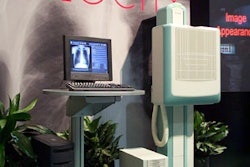(Radiology Review) Percutaneous transluminal angioplasty (PTA) of renal arteries should be the treatment of choice for patients with fibromuscular dysplasia that causes renovascular hypertension, according to French radiologists from University Hospital in Clermont-Ferrand. Dysplastic stenoses have been found to be responsible for one-third of cases of renovascular hypertension.
The authors retrospectively reviewed 70 patients with 87 dysplastic renal artery stenoses (RAS) that underwent percutaneous transluminal angioplasty (PTA) during a 13-year period. The average duration of hypertension was 13 years (one month-28 years), and patient age ranged from 20-81 years (mean 59).
"In 39% of cases the RAS had been detected by ultrasound, in 21% by digital intravenous angiography, and in two cases by scintigraphy," the explained. Renal arteriography was performed in 37% of the cases, they added.
PTA was performed following digital aortographic opacification using front and oblique views, followed by selective renal arteriography. There were bilateral dysplastic lesions in 23% of the cases. Right-sided RAS was found in 66% of the cases; one of these had two right-sided arteries with significant stenoses. Balloon diameter was chosen according to the normal renal artery diameter, and stenosis length determined balloon length.
"Hypocoagulating doses of heparin were administered immediately after the procedure and continued for 72 hours. The patient was discharged from the hospital three days after the procedure," they reported.
Patients were assessed every three months for two years and then once per year by measuring blood pressure, and serum creatinine levels. Follow-up radiological assessment was performed in 46% of patients. The treatment was technically successful in 94% of cases. Two non-medial dysplasias resisted balloon dilation and were treated with endoprostheses. Complications occurred in 11% of patients and included inguinal haematomas (7%), arterial dissection (3%), and acute renal insufficiency (1%). However no surgical intervention was necessary.
Their study demonstrated "good technical results, rare complications and infrequent recourse to endoprostheses" such as endoluminal stents. An older patient population, which often had associated dysplastic stenoses in other nonrenal arteries, led to a lower incidence of complete recovery in this study compared with prior research.
Percutaneous transluminal angioplasty of dysplastic stenoses of the renal artery: results on 70 adultsde Fraissinette, B., et al.
Radiology department, University Hospital, Clermont-Ferrand, France
Cardiovasc Intervent Radiol 2003 Jan/Feb; 26:46-51
By Radiology Review
July 30, 2003
Copyright © 2003 AuntMinnie.com



















